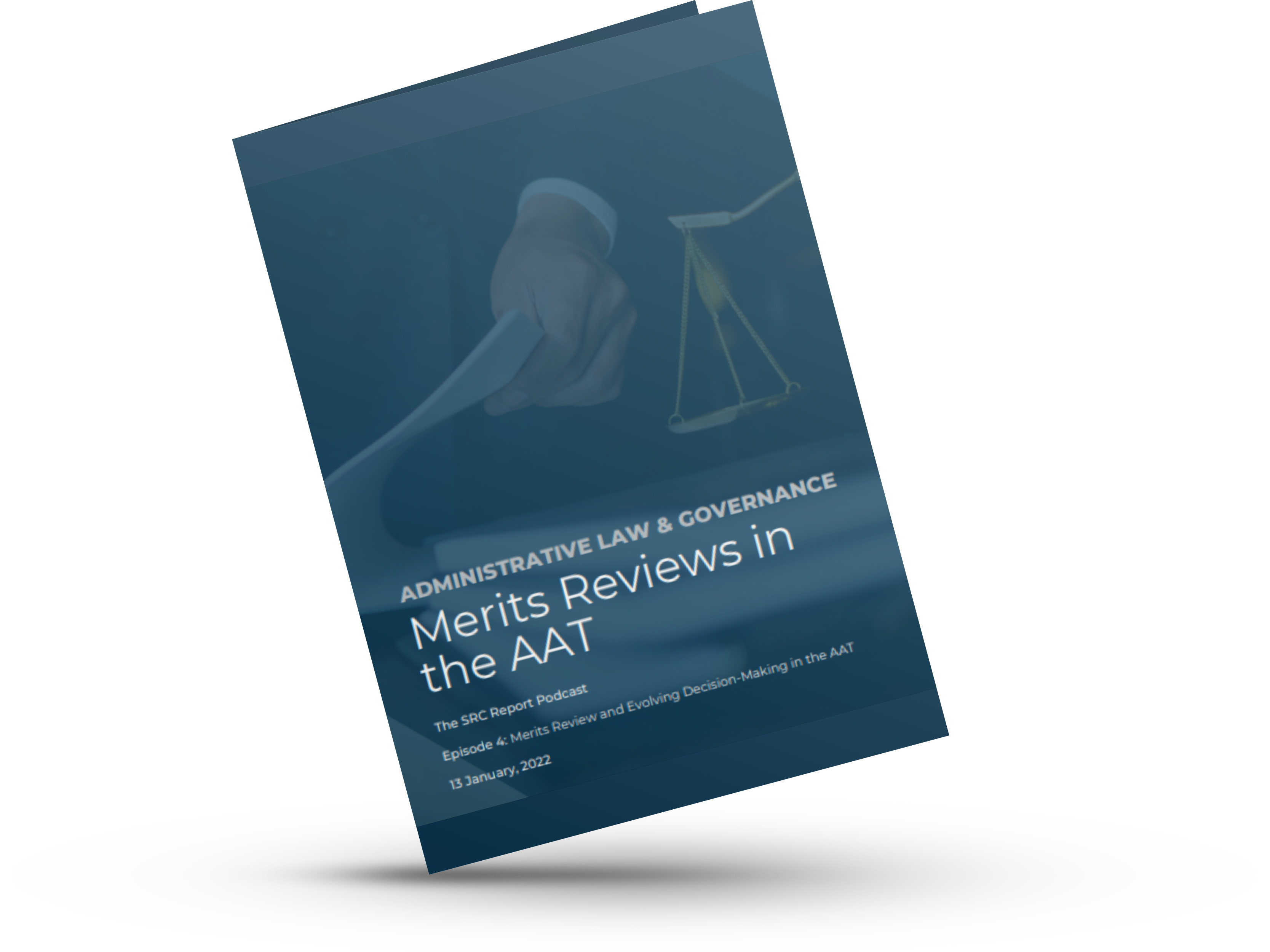ATHENA CAINS: Welcome to The SRC Report. I'm Athena Cains, Principal, from our Commonwealth Compensation team. And today, I'm talking to Jack Marshall, Senior Associate, from our Commonwealth Compensation team in Melbourne. Welcome, Jack.
JACK MARSHALL: Thanks, Athena.
ATHENA CAINS: Today, we're going to talk about merits review in the AAT and the evolution of decision-making based on some decisions that have recently come down from the Federal Court and the Administrative Appeals Tribunal. Now, Jack has recently presented on this topic for Morning Tea with McInnes Wilson. And you can find that video recording through our LawFlix, which is a subscription service that you can register for and has lots of really useful legal video presentations for you to have a look at, at your leisure.
Now, Jack, maybe we should just start at the very beginning. Can you tell us what the AAT is?
JACK MARSHALL: The AAT was established back in 1975 under the Administrative Appeals Tribunal Act. So, unlike the courts, the Tribunal doesn't have general review powers - its jurisdiction to hear matters is conferred by enactment. And so, I think the AAT has power to review decisions from over 400 acts, and one of those main acts - and the one which we're concerned about mostly in our day-to-day, Athena - is the Safety, Rehabilitation and Compensation Act. A few of the other major divisions of the AAT include migration, taxation and social services. So, what the AAT does, is it reviews decisions on their merits. So, it's a different, I guess, decision-making process to that of the courts, which undertake judicial review. So, the primary function of the AAT is reviewing a decision on its merits, with a view to reaching the correct or preferable decision, unlike the courts. The courts look at the application of law and the legality or the lawfulness of the decision.
ATHENA CAINS: So, Jack, what is merits review, and how is that different from what a court might do if it was looking at an administrative decision?
JACK MARSHALL: So, merits reviews involves taking a fresh look at the facts, law and policy relating to a decision. So, where a decision is made at first instance, and it's reviewed, and it finds its way to the AAT, the Tribunal can actually not only consider material that was available to the decision-maker at the time of making the decision, but it can also consider any new information or material or evidence that's being presented, or is relevant to that decision when the tribunal member hears the matter at the hearing.
So, pretty much what that means is that there's a whole body of new information, which is available to the Tribunal to consider, and that's at the core of merits review. It's an evolving process, and it gives the, I guess, the power to look at decisions in a fresh way, and that's, I guess, at the core of merits reviews.
So, how that differs to judicial review - is judicial review is mainly looking at the legal rights and obligations and is concerned with the lawfulness of decisions. It doesn't have that evolving nature of considering new materials that may have been available at first instance.

merits review in the aat factsheet
Find all the key information you need about merits reviews here.
ATHENA CAINS: And I think, Jack, that's really important because one of the things that the Tribunal has also is the power to compel the production of documents. Which, generally speaking, Comcare or licensees would not have the power to compel, and so that's where we may see some additional evidence. And we also, in the Comcare space, can see additional evidence from employers because Comcare is clearly not the employer, in most cases, of an employee who's got a matter in the Tribunal. And that evidence itself can be incredibly important in merits review and important in the Tribunal reaching its correct and/or preferable decision.
And I think, Jack, you talked about merits review, and obviously, that leads us to the Tribunal's role in the evolving decision-making under the SRC Act. Can you talk a bit about what that means - evolving decision-making - and how that's related to merit review and the evidence that we get in the Tribunal?
JACK MARSHALL: Sure, Athena. I think that the best way to have a look at that in evolving decision-making is actually to have a look at a recent case that the Tribunal heard, and this decision was handed down on the 6th of December. So, it's hot off the press, and that's the decision of Sprice and Comcare, but those interested in the citation, it's [2021] AATA 4564.
So, in that matter, what the Tribunal were looking at was a person, an employee of the Department of Defense, who had a number of workers compensation claims arising from injuries as far back as 1993 and early 2000s. So, there was an initial acceptance of liability from Comcare, and these were the accepted conditions - that was a neck, a left shoulder, a lumbar back and wrist sprains, as well as a chronic pain syndrome.
The decision before the Tribunal was a cease effects decision. So, Comcare said that the applicant, Mr Sprice, was no longer suffering the effects of those accepted conditions and that Comcare was no longer liable under sections 16 and 19 to pay compensation under those sections. So, the Tribunal, in the course of undertaking its merits review of the matter, was actually able to look back at the initial acceptance of liability which occurred back in the early 2000s, and there was obviously a range of new evidence available to the Tribunal that had been adduced in the matter over the course of the years, as compensation was paid under the SRC Act under various sections. And the Tribunal said that “Well, actually no, the reason that there's no ongoing liability under sections 16 and 19 is that the applicant actually doesn't even meet the section 14 tests”. So, the Tribunal said that the AAT are able to revisit whether liability was correctly accepted by a respondent for the accepted conditions under section 14 of the SRC Act.
ATHENA CAINS: Yeah, Jack, and that would be consistent with Federal Court authority as we've seen it currently coming down in the matter of Woodhouse, and also the matter of Prain. Which is one that, as lawyers, we look at a lot in terms of whether or not liability continues for a disease.
JACK MARSHALL: Yeah, that's right, Athena. So, I think an important comment from the Tribunal in that decision that I referred to - that's Sprice - is that it was observed at the SRC Act, and in course, the AAT and merits review. It allows for progressive and evolving decision-making to give effect to the provisions of ongoing review of relief or entitlements. So, as circumstances change and new facts arise, decision-makers need to give due consideration to that further evidence because that's what the Tribunal will do if and when those matters arrive at the Tribunal.
ATHENA CAINS: And I think that's a really important aspect of the SRC Act and how decision-making's been evolving under that Act because the SRC Act and workers compensation under that Act is a long tail scheme. Having evolving decision-making based on current evidence and being able to look back at initial liability and when liability may cease for injuries is a really important aspect of managing claims under the Act.
And I think, probably one of the key takeaways of these decisions and merits review under the AAT Act is that evidence is so crucial. And when we talk about evidence, what we mean is contemporaneous evidence from, potentially practitioners, but also from employers and managers regarding an employee's capacity, or the causation of their injury, or any number of factors and evidence that an employer may gather in the course of managing an ill and injured employer. What takeaways do you think there are, Jack, in those decisions in relation to evidence?
JACK MARSHALL: Well, that's a good point, Athena. It's open and available to employers to gather their own evidence. So, obviously, you've got the medical side of things and injured workers will continue to produce medical certificates and various contemporaneous evidence that's provided through the medical side of things. But it's also, I think, open to employers to get materials from co-workers who may observe certain things about an injured worker that may or may not be consistent with the other materials that are being presented. It's also open to employers. So, the key sorts of evidence that it is available to employers to gather and collate is evidence from managers going to the capacity of injured workers and their observations as to those activities or workplace duties that they can and can't perform.
We like to have seen things like fitness for duty assessments and rehab programs, both done informally and formally under the relevant provisions of the SRC Act. Those sorts of documents can be relevant to ongoing entitlements under the SRC Act and should be presented to Comcare for consideration as to those benefits or compensation to be paid. There's some of the key things that I can think of, Athena. Is there anything else that springs to your mind?
ATHENA CAINS: No, nothing in terms of the evolving nature of decision-making. And I think it's really important for employers to also remember, the ultimate goal of the SRC Act is rehabilitation and return to work. So, these kind of tools are relevant to managing liability, but at the end of the day, the most important thing we can be doing is supporting our workers to get meaningfully back to work. Because as we all know, good work is good for you, and having our employees back to work, performing meaningful work, is the fastest way to recovery and also the best way to manage your ongoing premium.
So, thank you, Jack. That was a really interesting talk today about the AAT merits review,. And then I think we sort of got much more deeply into the evolution of evolving decision-making, which was fantastic to cover off today. So, thank you so much, Jack.
JACK MARSHALL: Thanks for having me, Athena, I hope it's some use. And I think it's an interesting topic, and it's one that I guess we should all always be mindful of. But, as you said, I couldn't agree more. The main goal of all of this is to get our workers back in action because as you've said, it's beneficial on a number of fronts. So, thanks very much for having me here today.
ATHENA CAINS: Not a problem, and we'll have you back again soon, Jack.
JACK MARSHALL: Thanks, Athena.
ATHENA CAINS: Thank you, everybody.
Principal
Principal

